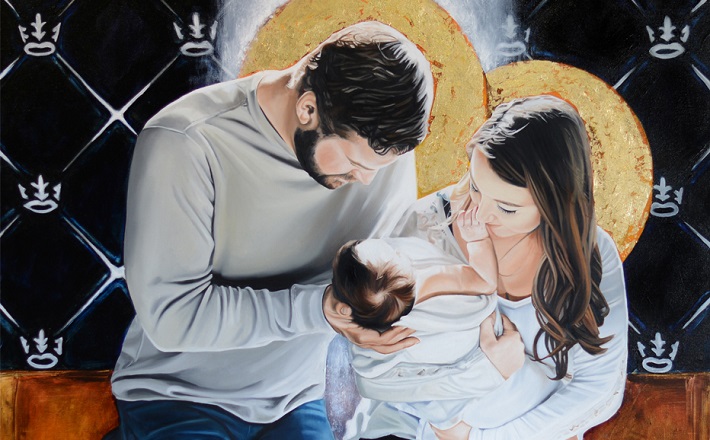Commentary on Titus 3:4-7
The reference to Jesus’ appearance in the flesh, which accords with the feast of Christmas that we celebrate today, is embedded in a series of moral instructions.
The letter to Titus here appears to be using a baptismal exhortation as it continues the moral advice that began in the previous chapter. In this, the letter draws out for us the consequences of Jesus’ appearance on earth and His salvific work on our behalf. It is striking that at the head of this section the letter calls for subjection to earthly rulers and authorities. This is good advice for a small community without legal standing and social clout.
For different reasons today, the advice still has pertinence as Christians in the United States strive to reform and improve our society from within. To be sure, the letter’s reference to Jesus’ birth highlights His embodiment of the widely prized virtue of “loving kindness” (Titus 3:4) or philanthropy (love of humanity).
Greco-Roman society of the day symbolized the virtue with the figure of a shepherd caring for his sheep. The Christian community readily applied the virtue and its image to Jesus, both literarily in the four gospels as well as in statuary, sarcophagus reliefs, catacomb paintings, and decorative domestic mosaics from the earliest times on. The shepherd image naturally flowed into the image of the sheep. From there, with reference to the sacrificed lamb on the eve of the Israelites’ departure from Egypt and the lamb whose sacrifice bore aware the sins of the people in Isaiah 53. The letter to Titus alludes to the latter when it mentions our being “justified” by our “savior” Jesus (3:5-6).
The second virtue of God that Jesus embodied in coming among us is “goodness” or “generosity,” a term often applied to describe benevolent monarchs. Thus, while the letter calls for subjection to earthly rulers, it contrasts those rulers with the diving ruler whose true benevolent action brought a total transformation for wayward humanity.
The waywardness, specified in verses 2 and 3, was universal and rooted in ignorance (“led astray”). It issued in a slavery to our baser selves. Replacing the malicious actions of the previous state, Jesus’ appearance saved us out of slavery and renewed us. It is now possible for us to be “obedient” and “ready for every good work” (Titus 3:1). The letter focuses on the contrast in fact between the actions issuing from “passions and pleasures” and those made possible by the renewal and rebirth through the baptismal water by the Holy Spirit.
The ancient calumny against Christians was that they were “haters of the human race, just the opposite of philanthropy. This charge was cooked up against them because they kept apart from the polytheistic rituals, the gladiatorial games, and even military service, choosing to worship by themselves in private. The anti-Christian calumny today rests on Christian opposition to other social practices in society at large that Christians denounce such as abortion, promiscuity, economic disparity and exploitation. In either context, the letter to Titus declares the truth that Jesus’ generous, loving kindness enlivens the life and actions of His followers.
The Holy Spirit brings forth the enlivening in the water of baptism that brings rebirth and renewal to the faithful baptized. Thus the birth of Jesus that we celebrate at Christmas looks ahead to our own birth in the Holy Spirit. Our celebration of Christmas recalls Jesus’ taking on humanity and at the same time it points to our taking on divinity in the Holy Spirit that is “poured out on us” (Titus 3:6).
We are brought out of the condition of slavery to sin and are established as children of God and “heirs according to the hope of eternal life” (Titus 3:7). The reference to eternal life thrusts our vision backward to the origins of our faith and forward to where the salvation won by Jesus is designed to lead us as heirs. St. Paul speaks of all the Gentiles as descendants of Abraham, heirs of the justification of their ancestor of the faith and recipients of the blessing of the Covenant (Galatians 3:6-9). There we are reminded that it was Abraham’s belief that brought him the righteousness of God (Galatians 3:6). So too here, in the letter to Titus, righteousness come to us through the “mercy” and “grace” of Jesus and not by “works of righteousness: (3:5-7).
As the letter to Titus insists, the salvific work of Jesus has made us “ready for every good work” (3:1). In saying this, the letter echoes Paul who at the close of the letter to the Galatians encourages them not to “grow weary in doing what is right, for we will reap at harvest time, if we do not give up” (6:7-10). Paul reflects Jesus’ own words in the gospel, such as those in Matthew 25:31-46, where Jesus makes inheritance of the kingdom continent on acts of generosity and compassion. Deeds, therefore, matter, as the letter to Titus insists. While they don’t make us righteous, they show us to be the people whom God has blessed and made worthy of His covenantal promises.
Our celebration of Jesus’ birth stretches our vision to the past event of Abraham’s faith and reception of the promise of blessing for him and his heirs, us included. The celebration also turns our view forward in time to Jesus’ death on the cross which won us a place in the family of Abraham and a share in the promised blessing. Finally, we gaze even further into the future where all who participate in an earthly life of virtuous action will share in the eternal life of heaven.


December 25, 2018